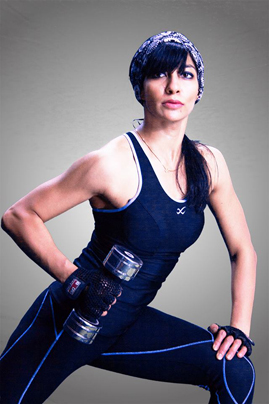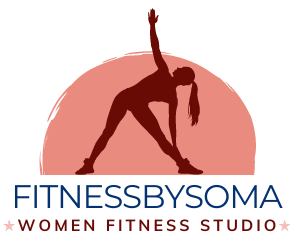At some point in my life, all I ever wanted was a six-pack ab, muscular toned body, and great-looking glutes. I have always been fascinated by strong well-built men and women since my teens.
Though ironically I used to be really thin scrawny and a pale looking teen, yet always wanted to be big someday.
And as they say what you really desire the universe will send it your way, somehow I landed up with the fascination and love for physical training, which led to acquiring various certifications (Fitness Trainer, Yoga Teacher life & wellness coach, NLP coach and a Nutritionist) after opening up my own gym for women, working with more than 100 clients over the period of 11 years, I have learnt a few important lessons about what real fitness is all about.
I will try and put my learning in a concise way as possible so you understand what it really means to achieve your health goals and what are the most important factors to look for while deciding what you really want to look like.
Our Fitness Industry has been selling the perfect Image of Flawless Health and Tight, toned bodies packed with lean muscles and no fat. We have grown up looking at such models on billboards, magazine covers, on social media. And they seem to make it all look so simple and easy, but trust me it isn’t that simple.
I have been there, tried it, done it all, and today with my experience I am going to tell all you women out there, that it’s a LIE. A big fat lie that the fitness industry wants to keep it under the cover so people can get fooled by the glamour and not what goes beneath it all.
So let’s get cracking…
I am going to talk first and foremost what really goes into getting that ripped and lean look that we all crave for.
As for me, that’s what got me started into the fitness craze, I was always on the leaner side so honestly didn’t have to struggle much on losing weight, but my obsession with a six-pack and fat loss got me all winded up into a frenzy which later on did cost me my health too… More on that later …
I did achieve a body fat percentage of 12% at the age of 34. When I started working out at the age of 32 I was at 24% fat. I started my own gym and right then fell in love with exercising and my goal of achieving the near-perfect body.
So I achieved my ultimate goal within 2 years, which is not bad at all given at the time I was a mother with two kids, a joint family, managing household, cooking, looking after, and also training clients. It was very taxing. I remember I was totally absorbed into it day and night, managing my diet, my workouts ( I used to train like crazy those days, I was always doing something physical, I was counting calories , stopped eating most carbs, only protein and good fat, I wasn’t enjoying eating out or going out with friends as I could not enjoy what others were eating, I became too obsessed with everything down to every little bite I would take, too disciplined, too much control over everything including the macros and the micros.
Well, this led to not only health problems as for women (unless you are a Competitive athlete) such low levels of body fat are very detrimental to your health. I sacrificed a lot during this time. I suffered a lot health-wise, mentally, and emotionally too. When I would fall sick It would take me a long time to recover because I had exhausted my body’s natural resources and I wasn’t taking enough energy to refuel myself. I was only looking at my abs…
Cut to now at present. I am 43 years old, with a body fat percentage of 21%. Have never felt better and stronger. I can do more and lift more than I ever did at 20 years of age.
So guys what I am trying to tell you in short through my story is that we all fall in this rat race to look good, but is it really worth the cost you pay?
Six-pack abs. Tight butts. Lean, vibrant, flawless health. That’s the image the fitness industry is selling. But have you ever wondered what it costs to achieve that “look”? What you have to do more of? What you really have to give up?
Make no mistake, there are real trade-offs as you attempt to lose fat and improve your health. Let’s talk about what they are. So you can consider how to get the body and health you want while living the life you enjoy.
.


The pic on the left is my old self with Fat Percentage at 12% and the pic on the right is my present self with Fat percentage at 21%
DO you find much difference?
So this is what I learned from the experts which I used on myself and now I am sharing with you:
Your body, your health, your choice
1. If you want to make further changes to your body, You’ll need to make further changes to your behaviors.
2. The leaner you want to get, the more of your behaviors you’ll have to change.
What you decide to change, and how much you decide to change it, is up to you. What’s most important here is that you understand what it actually takes to do what you want (or think you want).
What’s a healthy level of body fat, anyway?
First, for the sake of context, let’s take a look at some numbers.
Data tell us that most men can be healthy somewhere between 11-22% body fat. For women, it’s between 22-33%.
Getting the process started
The good news is that it’s not that hard to go from an unhealthy level of body fat to the higher end of “normal”.
You can do it with a few relatively small, easy-to-implement changes.
For instance:
- drinking less soda or alcohol each day
- not overeating desserts and fast foods (instead, just eating them in reasonable amounts)
- taking a daily walk or adding a yoga class
Assuming there are no other factors involved (such as a chronic health problem) if you make a few small changes like these, and do them consistently, in six months to a year, your body fat percentage will drop and fall into a much healthier range.
Now, of course, not every change will feel simple, small, or easy. Especially when you start out.
You’ll need to put a little extra effort and energy into making those changes happen every day. Nevertheless, if the changes are small enough, and you practice them consistently, you’ll probably find that eventually, they’re just part of your regular routine.
In fact, one day in the future, you might even say, “I just don’t feel like myself without my daily dose of exercise!”
“Overweight” to “no-longer-overweight” to “lean”
Suppose you’ve made a few changes like this.
Maybe you pack an apple in your lunch instead of apple juice. Or you include a salad with dinner, or you stick to one or two drinks with friends.
And you’re feeling good! Your knees have stopped hurting, plus your pants now button comfortably.
Now you’re somewhere in the zone of “a little extra padding, but not too bad”. You’re more mobile, healthier, and high in spirits.
What’s the next step?
Well, if you’re a man who wants to reduce body fat from say 18% to 14%, or a woman who wants to go from roughly 28% to 24%, you’ll need to make some bigger changes.
You’ll need to invest more time, energy, and effort. You’ll need to plan more.
And you’ll also have to make some trade-offs.
From “lean” to “leaner”
If you’re a man and you want to go from say 14% to 10% body fat, or you’re a woman and you want to go from about 24% body fat to 20%, it’s all a question of doing more…and less.
You’ll probably need to do more stuff, such as:
- getting more exercise and daily-life movement, and making that exercise more intense
- eating more vegetables and lean protein
- choosing more whole foods
- doing more meal planning
- getting serious about rest and recovery
- Learning your physical hunger and fullness cues.
You’ll probably need to do less stuff, such as:
- drinking less alcohol and other high-calorie beverages
- eating fewer processed foods
- Not eating when you’re not physically hungry.
And you’ll need to make these small changes consistently, over a period of time.
Many folks will decide that these changes are worth making. They want to look and feel better, get a good night’s sleep, get off medications, and so forth. So they’re ready to compromise.
Other folks will decide that they’re not yet ready to make more adjustments. And that’s fine too.
The most important thing is that you realize: In order to change… you have to change.
What it takes to get “super-lean”
At the next stage — going from athletically lean-to bodybuilder lean — the trade-offs get even more serious.
Here’s something that you may not realize:
Elite bodybuilders getting ready for a contest and models getting ready for a shoot are basically in a slow starvation process.
( I wasn’t trying to be any of this but I always believed this is how my body should look, my wrong belief led to my false perception of healthy weight and fat )
Adhering to an extremely strict and precise regimen of eating and training (and perhaps adding some drugs into the mix) is the only way they can drop their body fat to extremely low levels.
Males can get to body fat levels under 6% with this process, and females can get to under 16%.
But this process is not for the faint of heart.
It goes against biological cues. It requires exercising when exhausted. It demands ignoring their desire for food in the face of powerful hunger cues. It involves intense focus and dedication.
And it often distracts from other areas of life that these athletes might enjoy and value.
Imagine all the practical things that are involved in very strict dieting and training.
- You have to make your own food and measure every meal down to the last gram.
- That food is generally very plain — lean protein, steamed vegetables, plain potatoes or rice, etc.
- You have to carry that food with you so you can eat at a precise time.
- You cannot eat in restaurants.
- You have to do a specific workout on a given day, exactly as specified.
- No sick days, no slacking.
- You’ll probably be training 2 or 3 times per day.
- You have to sleep and recover precisely.
- No parties or staying up late.
- You can’t think straight because you’re always hungry and tired.
- Your whole life revolves around making food, dieting, training, and recovery protocols.
Is that level of leanness worth it? Nope, it isn’t!
Having a six-pack doesn’t automatically make you healthy. In fact, getting too lean can be actively unhealthy. My first-hand experience.
You might end up with amenorrhea, low libido, disordered eating, brittle bones, social isolation, and a host of other problems.
Some elite bodybuilders rely on drugs like stimulants, diuretics, and other drugs just to keep themselves going.
In short, being really lean has almost nothing to do with being really healthy.
Indeed, being too focused on getting lean may lead you away from good health.
If you look closely enough you will find that in real life, nobody’s “perfect”. Not even elite bodybuilders and fitness competitors.
Getting clear, getting real
Clarity is essential in change.
If you think you may want to change how much body fat you have, start by getting a clear idea of where you’re at.
- Figure out your goals and priorities. If you don’t know what your priorities are, now’s a great time to explore that.
- Decide what you’re willing to do right now in order to serve those goals and priorities. Why?
- Decide how often, how consistently, and how intensely/precisely, you’re willing to do those things.
- Decide what you’re not willing to do right now. Why not?
- In the above steps, be brutally honest and realistic yet compassionate with yourself.
This is just a general guide. It’s a start. Something to get you thinking.
Age, gender, genetics, medical conditions, and medications can all affect what you’ll need to do to get and stay lean.
A lean body isn’t always a fit or healthy body or belongs to a person with good habits. A body with more fat isn’t always an unfit or unhealthy body.
What to do next
1. Take the long view ( have patience)
Whatever change you want to make, remember: It will take time.
Eating one big, calorie-dense meal won’t make you wake up overweight. Fasting for 24 hours won’t give you six-pack abs.
A simple plan followed consistently is better than a complex plan followed intermittently.
2. Review what’s involved ( Plan ahead)
To reduce your body fat from unhealthy to healthy levels
You only need to make a few changes and follow them about 50% of the time.
To go from normal to reasonably lean
You need a few more changes and a bit more consistency.
Now you might need to eat protein and veggies at every meal, and get 7+ hours of sleep 80% of the time.
To go from lean to very lean
You’ll have to put in more time and more effort. Plus, you’ll need to follow your plan even more consistently — with almost obsessive accuracy.
This means adding a few more habits, such as monitoring fat and carbohydrate intake and exercising at least 5 hours per week 95% of the time.
That’s a serious commitment right there.
3. Get clarity on what YOU want ( Introspect)
Review the “getting clear, getting real” list.
What matters to YOU?
What are YOU willing to do… or not? Why?
There’s no right answer. What’s most important is that you understand what it takes to get a certain outcome.
And now YOU have the power to choose. Healthy, athletically lean, or super lean: It all depends on your priorities and goals.
Now you can make the decisions — and get the body and health you really need, while still living the life you really want.
Thank you for reading.
Source: www.precision-nutrition.com


Recent Comments